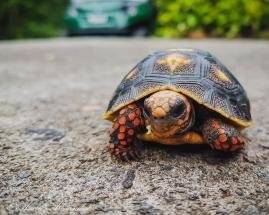
Turtles can also form social hierarchies and this is how they compete for food, partners and territory. This has been demonstrated by a study carried out by the researchers of the Biodiversity Conservation Unit at the University of Milano-Bicocca’s Department of Environmental and Earth Sciences.
The research focused on the behaviour of certain specimens of European pond turtle (Emys orbicularis galloitalica) and its results were recently published in the Animals scientific journal (https://doi.org/10.3390/ani10091510).
The turtles were studied during the rearing phase under controlled conditions (headstarting), which was implemented in order to drastically reduce their post-natal mortality in the wild, as part of a project for the reintroduction of the species in the Montevecchia and Valle del Curone Regional Park (Lecco), following its local extinction, which is thought to have occurred around a century ago.
The researchers observed the occurrence of various social behaviours among young turtles. During feeding, the researchers recorded bite attempts on both the head and tail, as well as simulations of riding, which has a different meaning to its reproductive significance in animals that have not yet reached sexual maturity.
Analysing the number and types of behaviour, researchers have shown that from around two months of age, young turtles can establish a genuine hierarchical structure comprised of dominant and submissive individuals, as happens in various bird and mammal species. Once formed, the hierarchies appear to remain stable over time, although differences in rank were not very pronounced, i.e. the submissive turtles were still capable of winning confrontations with a dominant turtle.
The study also showed that, unlike in the case of many mammal species, the social position of young turtles does not appear to be determined by their body size. Indeed, even the smallest turtles with a more aggressive character can dominate large turtles.
For a number of decades, the European pond turtle has been negatively impacted by the loss of natural environments and the introduction of invasive species (such as aquatic turtles sold by pet shops and then released into the wild) and it has disappeared in many areas of the country.
Reintroduction projects therefore make it possible to re-establish the original populations and raise awareness about various aspects relating to fauna conservation. These projects often include a breeding phase for newborn turtles, enabling them to quickly grow and survive their first stage of life, when they are most vulnerable.
“The fact that turtles are able to establish social structures not only contributes to our knowledge of the life of these fascinating reptiles,” explains Luciano Bani, professor of zoology at Milano-Bicocca, “but is also an important practical aspect that must be taken into account during turtle breeding in order to reduce aggressive interactions and to ensure the optimal health and growth of animals involved in breeding projects under controlled conditions. The next challenge for researchers is to study social behaviours in a natural environment, such as the pond in the Montevecchia and Valle del Curone Park, where turtles were successfully released in the summer of 2018 and remain healthy”.